How to add signatures in different languages
Find out how to manage multiple-language email signatures and automate the signature adding process in CodeTwo Email Signatures 365.
Multinational organizations or companies that serve customers from different countries very often send their entire correspondence in English. As it is a global language, it is understood by the vast majority of recipients. However, you might want to consider adjusting the language of your email to the language of a recipient to:
- overcome the language barrier and avoid miscommunication,
- gain the trust of your customers by speaking their language,
- show your clients that you are ready to go the extra mile to meet their needs,
- get access to a wider market or globalize a specific product,
- improve your results with targeted email campaigns.
While it's not always possible to write every email in the language of your customers, you can use an email signature that "speaks their language". Email signatures are a crucial part of your business correspondence, as they include your company's contact information, promote brand awareness, contain legal disclaimers and so on. CodeTwo Email Signatures 365 offers multiple solutions that can be used to ensure a correct signature, in the right language, is always inserted into all outgoing emails.
New to CodeTwo?
Learn more about signature modes our solution can work in. See how to set up your first signature rule and design an email signature template.
Use the links below and find the solution that best serves your needs, depending on your environment and the signature mode you use in CodeTwo Email Signatures 365. Also, be sure to check these general tips that apply to all usage scenarios.
All signature modes:
- Automatically add signatures in different languages based on email recipients
- Automatically add signatures in different languages based on email senders
Cloud (server-side) mode only:
Outlook (client-side) mode only:
- Create a separate signature rule for each language version of your email signature.
- If you want to use the same signature template in another rule, create a new rule by using the Clone button (visible after selecting a rule) in the signature management app's main window. Next, you only need to change the conditions/exceptions of the new rule and translate the contents of the template into a different language.
- All solutions described below provide information on how to configure a signature rule for a specific scenario. For more information on how to:
- configure additional rule conditions and exceptions, see this article,
- design a signature template, see this article.
Automatically add signatures in different languages based on email recipients
CodeTwo Email Signatures 365 lets you create signature rules based on email recipients. In other words, you can configure the program to add email signatures in a specific language based on the email address of a recipient or the domain to which you send your message.
To do this, sign in to app.codetwo.com and create a new signature rule.
Go to the Recipients step. There are different ways of configuring recipient-based conditions. For example, if you want the program to add a signature:
- in French to all recipients whose email addresses end in .fr (France) or .be (Belgium), etc., click Add > Email addresses and, in the window that opens, enter these top-level domain names. Be sure to add an asterisk (*) before them, as shown in Fig. 1. Click OK to apply.
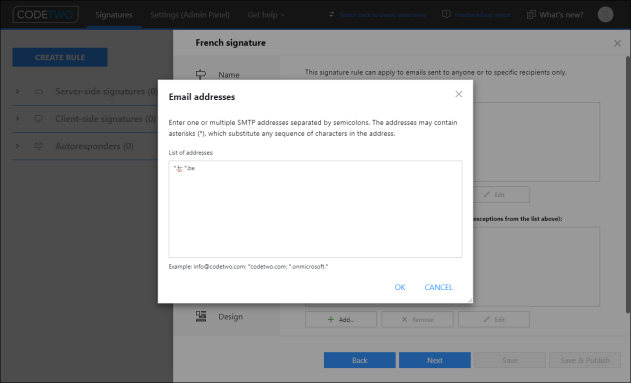
Fig. 1. Defining top-level domain names of email addresses as recipients of your emails.
- in German to all messages sent to your clients from German-speaking countries, click Add > Email addresses and, in the window that opens, either specify their individual email addresses (e.g. martin.s@my-company.de) or enter a domain name associated with email addresses used by a specific company (e.g. example.at). Be sure to add an asterisk (*) before the domain name, as shown in Fig. 2. Click OK to apply.
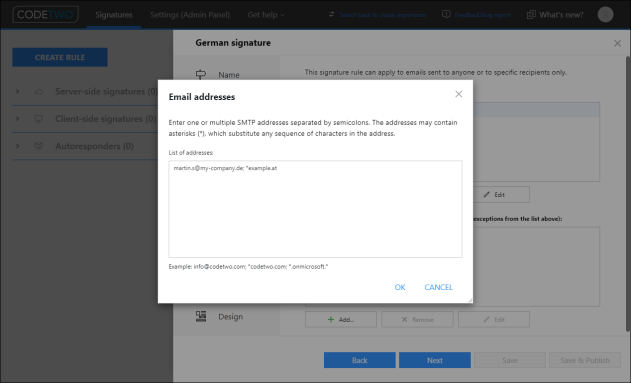
Fig. 2. Defining specific email addresses or domains as recipients of your emails.
- in your native language only to internal recipients, select Add > Internal recipients, as shown in Fig. 3.
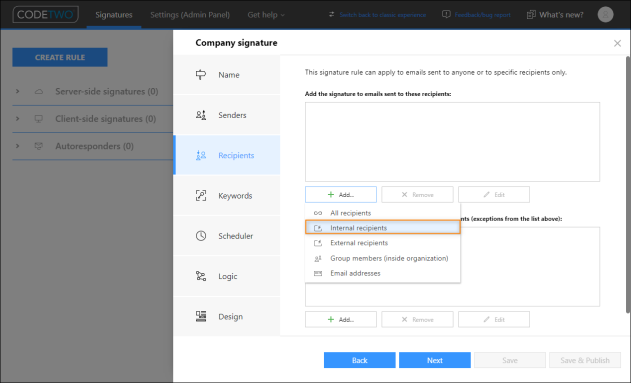
Fig. 3. By selecting this condition, the rule will add a signature only to messages sent inside your organization.
Configure conditions (and exceptions) for other steps as desired. For more details, see this article.
Next, go to the Design step to create a signature in the right language. See this article for step-by-step instructions.
Once done, submit your rule by clicking Save.
Repeat these steps to create separate rules that will be used to add different signature templates (in different languages).
Default email signature - cloud (server-side) signatures only
Be sure to create a cloud signature rule for adding a default email signature (e.g. in English) and place it at the bottom of the cloud (server-side) signatures list (Fig. 4.). Use the Move up and Move down buttons in the app's main window to change the position of rules in the list.
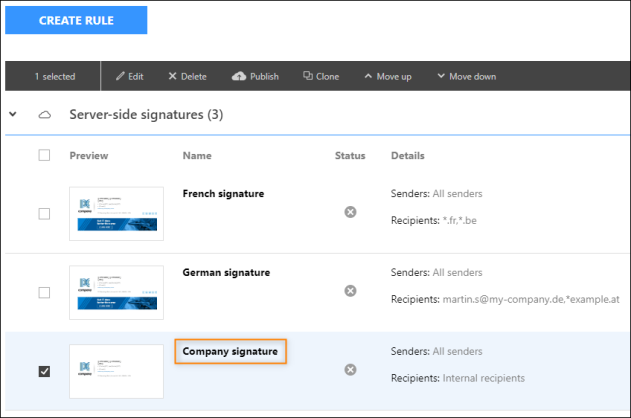
Fig. 4. In cloud (server-side) mode, always place the rule that applies to the broadest number of users at the bottom of the rules list.
Once you have created the required rules, select all of them and click Publish selected. This will make the signatures active in your organization (Fig. 5.).
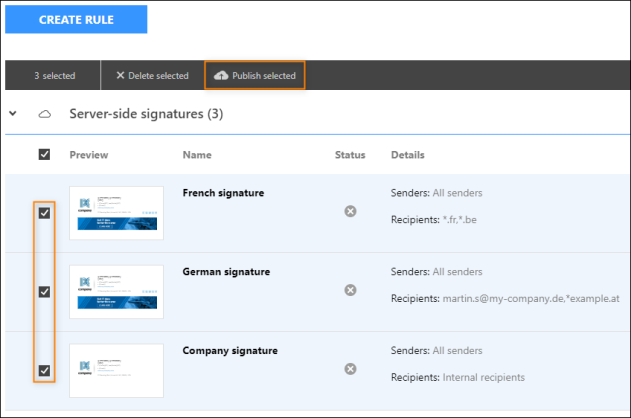
Fig. 5. Publishing the prepared signatures.
Read this article for more examples of how to create signature rules based on recipients
Automatically add signatures in different languages to emails sent by particular users (senders)
If you know that specific users or groups of users communicate only in a selected language or with customers from a specific country, you can define signature rules to automatically add email signatures in that language to all emails sent by these users/groups.
Note that you can create sender-based rules in all signature modes. However, when setting up Outlook (client-side) rules, you can also set up signatures that your users can select manually in Outlook when composing an email. See this section for detailed instructions.
Start by creating a new signature rule in app.codetwo.com.
Next, in the Senders step select:
- Add > Selected senders to apply this signature rule to individual users only,
- Add > Group members to apply this signature rule to a group or groups of users (e.g. a distribution group; read this Microsoft article to learn how to create such a group in your Microsoft 365 tenant),
- Add > Azure AD filter to apply this signature rule to all users that fulfill certain conditions. E.g. the program can add a German signature to all messages sent by users whose Country Entra ID (Azure AD) attribute is Germany (Fig. 6.).
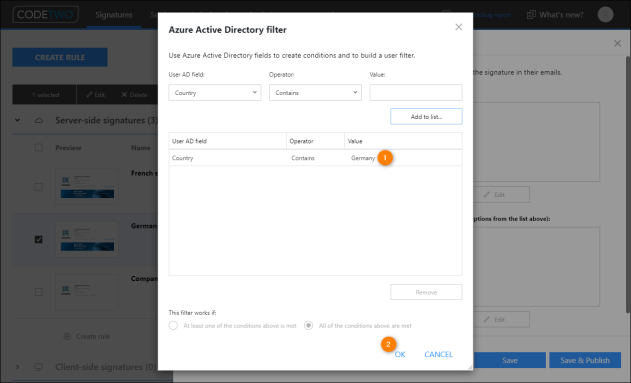
Fig. 6. The Azure AD filter options lets you add a signature to all users who meet certain criteria.
Configure conditions (and exceptions) for other steps as desired. For more details, see this article.
Next, go to the Design step to create a signature in the right language. See this article for step-by-step instructions.
Click Save to submit your changes.
Repeat these steps to create separate rules that will be used to add different signature templates (in different languages).
Default email signature - cloud (server-side) signatures only
Be sure to create a cloud signature rule for adding a default email signature (e.g. in English) and place it at the bottom of the cloud (server-side) signatures list (as shown in Fig. 4.). Use the Move up and Move down buttons in the app's main window to change the position of rules in the list.
Once you have created the required rules, select all of them and click Publish selected. This will make the signatures available to your users (Fig. 7.).

Fig. 7. Publishing the prepared signatures.
Read this article for more examples of how to create signature rules based on senders
Let your users select a signature in a specific language by using keywords (cloud signatures only)
When CodeTwo Email Signatures 365 works in cloud (server-side) mode, signatures are added automatically based on rules you define in the signature management app. However, if you want your users to have more control over which signature should be used (e.g. a French one instead of a standard English signature), you can define keywords or phrases that, when inserted in an email subject or body, will force the program to add a specific signature.
To set up the program for this scenario, sign in to app.codetwo.com, create a new cloud (server-side) signature rule and name it e.g. German signature.
Go to the Keywords step and click Add. You can configure the rule to add a signature when the program:
- finds a phrase in a specific language in the subject or body of an email. For example, if you always end an email written in German with the phrase Mit freundlichen Grüßen, enter the entire phrase in the Add phrase window (Fig. 8.). In this example, the program should not remove that phrase from an email, so leave the checkbox unchecked.
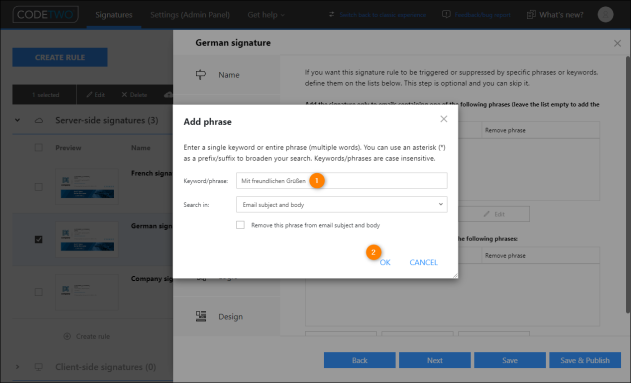
Fig. 8. Defining a phrase that, when used in an email, will trigger a signature rule.
- finds a specific keyword, e.g. #de, either in message subject or body. It would be a good idea to delete that keyword from your message, so make sure to select the right option, as shown in Fig. 9.
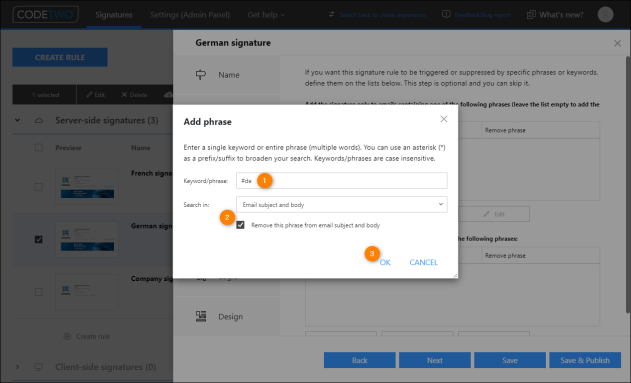
Fig. 9. Select the checkbox shown above (item 2) if you want the program to delete the defined keyword from an email.
Next, go to the Design step to create a signature in the right language.
Once ready, click Save to submit your rule.
Create as many cloud (server-side) signature rules as many language versions of signatures you need. Be sure to use a different keyword/phrase in each rule.
Repeat these steps to create separate rules that will be used to add different signature templates (in different languages). Be sure to create a rule for adding a default email signature (e.g. in English) and place it at the bottom of the signature rules list (as shown in Fig. 5.). Use the Move up and Move down buttons in the app's main window to change the position of rules in the list.
Once you have created all the required rules, select all of them and click Publish selected. This will make the signatures active in your organization (see Fig. 10.).

Fig. 10. Publishing the prepared signatures.
Check this article for more examples of using keywords to trigger signature rules
Let your users select a signature in a specific language when typing an email in Outlook
If you are using CodeTwo Email Signatures 365 in Outlook (client-side) mode, your users get their signature automatically in Outlook (desktop, mobile & OWA) when typing an email. See the sections above to learn how to set up automatic signatures based on email senders and recipients.
Your users can also select a different signature manually from the add-in pane in Outlook desktop apps and OWA. If you want them to have access to signatures in different languages and be able to choose the correct one depending on who the recipient is, configure the program by taking into consideration the following points:
- Create as many Outlook (client-side) signature rules in the signature management app as many language versions of signatures you need.
- Use descriptive names for your signatures, e.g. German signature, Spanish signature, English signature, etc. That way, your users can easily identify each of them in Outlook.
- If you want to limit access to specific signature templates to selected users only, go to the Senders step and configure rule conditions accordingly. Refer to this section to learn about some of the possible options.
- In the Logic step, configure Outlook signature adding options accordingly. For example, if you don't want the signatures in other languages to be added automatically to emails, be sure to clear (unselect) the options shown in Fig. 11.
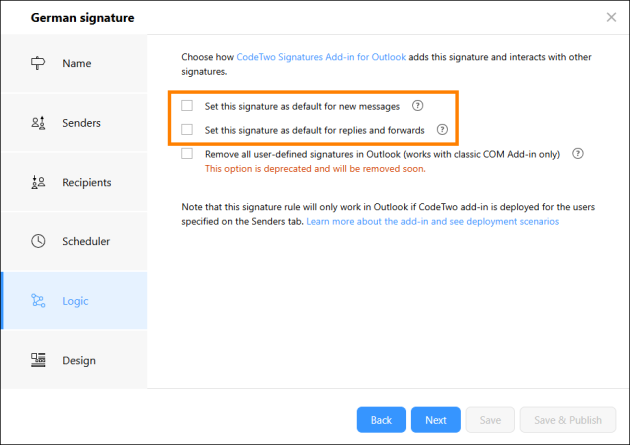
Fig. 11. Leave these options unselected if you want users to select this signature manually.
Result
Depending on the solution you choose, the signature in a given language will be either automatically added to the sent email or will be made available for your users to use by either providing a specific keyword in a message or clicking the Use this signature button in the CodeTwo Signatures pane in Outlook desktop or OWA (Fig. 12.).
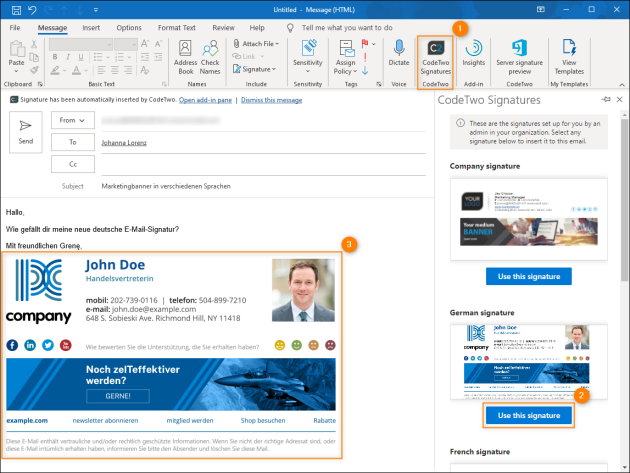
Fig. 12. In Outlook (client-side) mode, users can access signatures in different languages directly in the CodeTwo Signatures pane.
The table below shows the comparison of all the solutions described in this article.
| Email signature | Signature mode* | Is signature adding automated? | Can users select other signature? |
|---|---|---|---|
| Based on recipients | All | Yes | Cloud signatures: No Outlook signatures: Yes |
| Based on senders | All | Yes | Cloud signatures: No Outlook signatures: Yes |
| Triggered by a keyword/phrase | Cloud (server-side) |
Yes / No |
Yes |
| Selected manually in Outlook | Outlook (client-side) |
No (signatures are selected by users in Outlook) |
Yes (in Outlook desktop & OWA) |
* Combo mode is a combination of cloud and Outlook modes, so it supports all scenarios described in this article. By default, the scenario applicable to Outlook (client-side) mode will only work for messages sent from Outlook for Windows, Outlook for Mac, and Outlook on the web (OWA). Find out more about using the CodeTwo Signatures Web Add-in for Outlook and OWA in combo mode
In this article